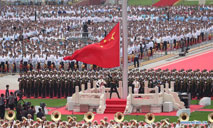Traditional papermaking brings riches to remote township
HEFEI, July 6 (Xinhua) -- In a workshop, laborers pound Blue Sandalwood bark and rice straw to extract fibers, then use cloth to filter out impurities and dust, finally attaining a white pulp.
These are some essential steps to make Xuan paper, a delicate, long-lasting type of paper traditionally used for Chinese calligraphy and painting. It is mainly produced in Dingjiaqiao, a landlocked township in east China's Anhui Province.
Today, with its popularity both at home and abroad, Xuan paper has become an important source of income for residents of the township that is home to over 200 Xuan paper manufacturers.
Dingjiaqiao has a 1,000-year history of producing the paper. The process of making Xuan paper was also added to UNESCO's world intangible cultural heritage list in 2009.
Zhang Yueling, 47, has a job packing and shipping the paper at a local enterprise. She is one of over 10,000 people in the township engaged in the Xuan paper industry.
Returning to her hometown from a city 10 years ago, Zhang found a job near her home to better take care of her child and parents. She earns about 3,000 yuan (about 463.5 U.S. dollars) a month.
"It's much more convenient working here," said Zhang, who previously worked as a waitress, adding that her husband and brother also work in local Xuan paper enterprises.
As China's largest production base for the paper, Dingjiaqiao produces over 1,000 types of Xuan paper products, bringing in an annual sales revenue of over 1.5 billion yuan. Some products are exported to countries including Japan, the Republic of Korea and Malaysia.
Wang Juling, sales manager of Anhui Changchun Paper Co., Ltd., said the firm's export revenue reaches approximately 20 million yuan a year, accounting for one-fifth of total sales.
Established in 1985, the company developed from a small, family-run workshop to a major manufacturer with stores across China. Wang said the company is eyeing an expansion into overseas markets.
E-commerce has also fueled local sales.
Cao Yang, 26, returned from Hangzhou, an e-commerce hub in east China's Zhejiang Province, to Dingjiaqiao several years ago. He is in charge of e-commerce at a local Xuan paper company.
"We deliver over 500 parcels each day. Annual e-commerce sales were over 5 million yuan last year and keep rising," said Cao.
By the end of 2019, over 500 business entities in Dingjiaqiao had engaged in e-commerce, achieving a total annual sales revenue of approximately 200 million yuan.
For Cao, e-commerce offers more opportunities and possibilities for this traditional craft. His company also designs and produces many creative products related to Xuan paper, including fans and scrolls, to meet the modern demand of the market.
"As more experienced migrants returned to Dingjiaqiao, the township has seen a growing number of milk tea shops, cake shops and cars, which offer us a glimpse into the vitality and influence of this intangible cultural heritage in the modern era," said Cao.
Photos
Related Stories
- Exhibition about intangible cultural heritages conservation kicks off in Hebei
- E-commerce development in western China is moving onto fast track
- Digital economy thrives in China's western regions: report
- Inheritors of China’s wonderous intangible cultural heritage
- Chinese "durian of soup" makes national list of intangible cultural heritage
Copyright © 2021 People's Daily Online. All Rights Reserved.










